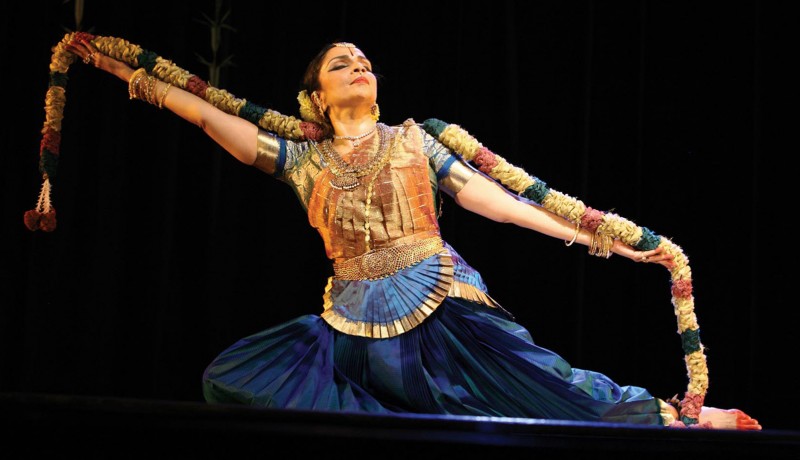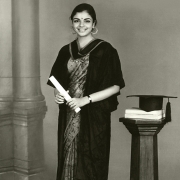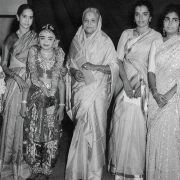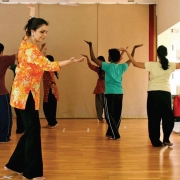
People

On the eve of premiering her new production this December season, iconic contemporary dancer Anita Ratnam tells Sai Prabha Kamath what keeps her going
Power. Piety. Purity. Veteran dancer Dr Anita Ratnam’s Neelam…Drowning in Bliss, a solo psalm in the spirit of surrender, had it all. Inspired by the serene stillness of the southern Indian Vaishnava ritual tradition, the poetry in motion presented recently in Mumbai was indeed a visual treat; innovative choreography with an irresistible mix of dance, theatre, music and lighting made the presentation an immersive experience. Through her unique movement vocabulary called Neo Bharatam—a signature style that breaks away from traditional dance formats and infuses modern aesthetics that are experimental in nature—Ratnam held the audience in raptures. Draped in creative, unconventional costumes, and with a graceful demeanour, she explored the various spaces on stage with softly rounded movements, brilliant expressions and interesting props. “Using all the elements of my physical vocabulary—Bharatanatyam, Mohiniattam, Kathakali, yoga and Tai Chi [a silent meditative movement]—into a choreography is very, very challenging. Each performance is like going back to the drawing board,” she expressed on the sidelines of the performance.
While in Neelam, the dance icon showcased versatility through her portrayal of myriad characters—Nambi, Kothai, Padmavathy, Krishna, Rama, Sita—in real life, too, Ratnam straddles multiple roles with consummate ease. Apart from being a performer-choreographer, she is an arts entrepreneur, culture mentor, writer, speaker. An “intersectionist”, her work weaves the many disciplines of dance, theatre, spoken word, ritual, archaeology, dramaturgy and women’s issues. Over the past four decades, her distinguished career has witnessed over 1,300 performances across 37 countries. Her acclaimed choreographies include Gajaanana, Daughters of the Ocean, Seven Graces, Ma3ka, A Million Sitas and Neelam.
A visiting professor in international universities in the US such as the University of California-Irvine and Riverside, Ratnam is also vice-president of ABHAI, a Chennai-based arts organisation that represents the Bharatanatyam dancers of India. As a fellow of the World Academy of Arts and Sciences and voting member of the Dance Critics Association in the US, she furthers the profile of Indian dance internationally, and mentors actors and dancers through a pioneering national project called Padme. The Chennai resident is also on the advisory board of Adishakti, a theatre laboratory in Puducherry. Ratnam is the founder of www.narthaki.com, the world’s largest web portal on Indian dance. In her ancestral village temple of Tirukurungudi, Tamil Nadu, she has restored the 15th century theatre ritual performance of Kaisika Natakam. And for over two decades, she has conceived, produced and curated numerous conferences, theatre seminars and dance festivals, the most notable being The Other Festival, India’s first annual contemporary dance festival in Chennai.
Interestingly, the artist hails from the reputed TVS Group business family (she is the great granddaughter of group founder T V Sundaram Iyengar). But she is quick to tell us, “The myth of the TVS family is just that—a myth. We were a very simple family.” In an exclusive interview with Harmony-Celebrate Age, Ratnam talks about her life, art, inspiration and upcoming projects.
IN HER OWN WORDS
In flashback, it seems like a fairytale. I was the firstborn—a true Alpha Female. My father being the eldest of his generation, I was spoilt by all my uncles and aunts. My mother wanted her firstborn to be a boy and there I was! So my aunt and my father decided on my name. Thank God that I was not named Lolita—my mother was horrified at the thought! In the mid-50s, a Tamil Brahmin girl named Anita was highly unusual. My middle name was Raajyalaxmi—named after the paternal grandmother we never knew.
I was the apple of everyone’s eye. I loved the spotlight, being the centre of attention. I never remember being shy or withdrawn. Always ready to dance, prance and sing when there were guests. Quite a show-off! Childhood was simple but filled with activity, studies, sports, languages, tuition, reading, drama at school… there seemed to be no time to dream or just be. In hindsight, this was the best way to bring me up… restless and very curious. Far better to have kept me busy and, at the end of the day, exhausted, rather than give me time to get into trouble.
The early days were extremely simple. Remember if you can, a time before television and the handheld social media revolution. Reading, long walks on the beach, hiking in the mountains for summer vacations—those were the times we spent as siblings and a large band of cousins. I remember being so thrilled when my father would return home from office with a Kit Kat chocolate bar as a treat—those were the days before Kit Kat and all imported products were banned and difficult to procure. Learning to ride a cycle, memorising full pages of text for theatre class, practicing for the basketball matches where I was star shoot, marching practice, singing classes, Carnatic and Western… the days were filled and I was filling up with all the software needed for life.
My mother always told me, ‘Be the first one on the moon, nobody remembers the second.’ It was after the first moon landing that she turned around and shared that line. My father was the soft one, loving and supportive. My mother drove us hard—traditional values at home and international citizens in the making outside. Horse-riding, French classes, wearing western clothes, modelling stints, playing the guitar, we were exposed to it all, and I loved it the most. My brother disliked the arts and my sister was more intent coming first in class. I was the curious global nomad in the making. At home, we studied Sanskrit and written Tamil. In school, we learned Hindi and French. As a family, we were the most modern in the entire TVS Group. Many of my cousins and friends would envy our freedom. Our home was a shelter for many of them when they fought with their parents or wanted to rebel in one way or another.
Today, I live in this family home which is 50 years old. It’s not old by Indian standards, but by my family’s rule of thumb, it is an old home. It was built by my mother Leela who was a civil engineer. She was also an amazing artist, building four homes in her lifetime, organising fashion shows, playing competitive tennis and golf while offering her energy and time to many social causes around town. She was impatient with laziness and sloth. ‘Sweat it out,’ she would urge us. ‘Depression and mind games are for the spoilt and arrogant.’ Another one of her wise sayings was, ‘You are not sugar or salt to melt in the storm. So go out and face it. But choose your battles.’ Playing sports was very important for our family. We learned how to win and lose gracefully on the court and in life. And believe me, I have faced so many losing moments.
Money was not freely flowing in the early days. My father brought home about ₹ 2,000 a month. That was all. We had very little money as everything was poured back into the company and its future. Today, my cousins enjoy a very different lifestyle owing to the hard work, vision and sacrifice of the previous generations. I remember the times of my mother paying for our traditional jewellery instalments.
I am the first professional artist in my family. Neither side has artists. I am surrounded by ancestors who were decorated lawyers, IAS and IFS officers, bankers, accountants, doctors and now business entrepreneurs. An artist? Nobody stepped into that world. And it was the only world that suited me. I am not employable. I cannot work 9 to 5, answering someone else’s call and developing another brand. I am it. I am the factory, the think tank and the manufacturing core. Think about it. The dancer uses her body as the machine and the temple, creating and destroying. When I stop dancing, the dance ends. Not having much to discuss by way of ROI [return on investment], balance sheets and turnover, other than ideas and passion, I am still ignored by many in my family as a dreamer or too much of an individualist. But my status in my family is devalued only if I allow it to happen. I refuse to believe that economics is the only horizon for success. I cannot negate all my years of work and art to submit to that monolithic way of thinking. I have been able to walk into the homes and offices of great men and women. Kings, prime ministers, presidents have all welcomed me, not because of my bank balance but because of what I represent.
I was an excellent student of my dance gurus. First, Rajee Narayan and later Adyar K Lakshman. I excelled in all they taught me and later was introduced to Kathakali and Mohiniattam to lend more flexibility and torso movement for theatrical representation. This was in the early 1970s. So you can say that I was unconsciously moving towards creating my own style: Neo Bharatam.
Neo Bharatam was named after I returned from the US and returned to dance. From 1976 to 1990, I studied theatre, film, television and anchored the first television show for the Indian community in the US. I was a star in the community of mostly North Indian merchants and businessmen. I became fluent in Hindi and some Gujarati to get closer to the advertisers and their families. I worked 20-hour days in New York City and realised the truth of the saying, ‘If you can make it there, you can make it anywhere.’ What a life and what a city! It has shaped my professional ethic and worldview to a large extent.
Nibbling at television topics day in and day out for 10 years with constant deadlines took its toll. I became too successful for my marriage. Perhaps that is a graceful way of putting it. Why does a marriage that is also a successful business partnership fall apart? The old story of ego, rage, greed, anger… all these were swords to hack our relationship into pieces. I was a young, 30 year-old mother with a two year-old daughter and a newborn son. India and my home were the safest place for them to grow up. And so India it was. Not a professional choice but a decision made as a mother. I returned to my mother’s home, but I was not the daughter who left home over a decade ago.
The year 1990 was the cusp of huge change in India. I sensed it. I had to bring my media experience and my older knowledge of the arts into a synergetic whole. Dance was what I knew best. A foundation is what was needed to become the umbrella for my interests. So with some seed money from my family, Arangham Trust was created in 1993. The first venture was the now famous dance directory, Narthaki. It was a phonebook for dancers. Overnight, it became a smash hit. A second edition in 1997 and now its award-winning online avatar from 2000.
Critical response to my Neo Bharatam style was cautious and slow. As I developed a collaborative approach to my performances—costume design, lighting, set design, music composition—audiences loved it but critics thought I was devaluing the core of the art. My aim was to respond to the rapidly changing world. Visual stimulation was the first marker of a live performance. Using all the elements that catch the ‘optic’ also shapes the early opinion of the rasika [connoisseur]. I create from mythological and historical themes where female characters can be given voice and flesh. Imaging women on stage is my focus and performance is my tool. I cannot say that dance completes me but I can admit that when I dance, the world seems brighter and takes on more intense meaning.
Critics and purists are still suspicious of what I do but there is no doubt in the minds of the audience and the young dancers who flock around me via emails and personal meetings. I have also broadened my interests—cinema, fashion, history, mythology, textiles, food, travel, music, modern dance, theatre, opera. I consume it all like a hungry sponge.
Life around me is what fuels my interest in dance. Dance is perhaps the best way to recognise me but dance does not complete me. I do not miss dancing if I don’t have a performance for a month. Surprising? Perhaps, but true. I find walking on the beach in Madras one of the most therapeutic moments. There are many things that stimulate me… even a beautifully prepared meal.
Entrepreneurial instincts run in my family. But nothing has been or was created with the sole purpose of getting rich. How can I give back to the art that has given me so much? I refused to teach young students, seeing that Madras already had more than 500 dance schools. I also realised that I was not cut out to be a teacher in the traditional sense. Impatience and constant questioning hover over me. So my challenge was, how could my unique abilities of life in two continents be harnessed to create solo compelling works as well as mentor the next generation?
Growing older as an artist poses different challenges. A dancer’s body ages, like we all do. But on stage, public perception wants the dancer to be fixed in a certain way. The face, the torso, the limbs, the waist, the smile… all demand a call to eternal youth. That is impossible to achieve and maintain. My own ideals at 20, 30 and 40 were changing, shifting to more realistic horizons. I could not conquer the world, change people’s hearts, make them less angry, greedy, cruel and more just, kind or wise. Art cannot do that, and dance is the hardest to carry social messages. What I can hope to convey through the performance is, perhaps, the value of beauty, the value of belief and determination, and the promise of a something that goes beyond the horizon of the mundane. And if I can make the audience hold on to one memory the next morning after the performance, I have succeeded in making that connection.
Being a mature woman, turning 60 is a huge moment. In many parts of the world, dancers retire at 40. In India, we are fortunate to have a life beyond that. But what is the kind of performer I want to be? What do I wish to say on stage and how do I hope to inspire the younger generation? These questions always shadow me. Maintaining my health and appearance are top priorities. Menopause and other transitions came and shook my disciplined lifestyle and I have had to change my diet and exercise patterns quite drastically. Dance does not automatically mean you will be slim and fit. There are so many Indian dancers who are out of shape. I cross-train, ride a bicycle, swim, run, do cardio, Pilates, yoga, pranayama… a variety of physical routines to always shake up the body and muscles.
Watching ageing dancers desperately cling on to centre-stage can be embarrassing. That is why I have slowly shifted gear. I mentor dancers who want to make the transition from student to professional. Mentoring young dancers is an important part of my core mission. Motivating and encouraging young dancers to train and conduct themselves in a way that is thoroughly professional and not to lapse into the tired clichés of ‘dance is sacred, divine and pure’. There are so many more skills a dancer needs: communication, flexibility in approach, adaptability to various audiences and choreographers. And, most of all, the fierce discipline to achieve excellence. I ask them to look around. Life is beautiful and full of opportunities.
Single parenting for 27 years has also not been easy. But with the flush of youth behind me, it is easier to focus on my kids and their future. Both of them are creative. My daughter Arya Saraswathi [28] is a novelist and my son Shriman Narayan [26] has a degree in filmmaking. They are very different and independent. Knowing the unpredictability of a creative life, I need to give them the life skills to deal with the uneven playing field that is life.
Archiving and documenting my work of 40 years is taking my time these days. I perform an average of once a month. That is enough for me to concentrate on other things. I am overseeing www.narthaki.com. It is now entering its 16th year.
My geography is my history. I acknowledge my presence: Tamil, female, Brahmin, Indian, mother, daughter, sister. I am a loner and prone to melancholia and anger. I use both moods as an advantage. Ideas and inspiration can come from anyone—young and old—at any time. I just have to be prepared like a sponge, a net, a blotting paper, to catch the essence.
Urban spaces in India are increasingly crowded and art is being pushed out of the national discourse except when there is a controversy. Dancers are rarely taken seriously and looked at more with curiosity. I fight for the legitimacy of myself, my art and my lifelong pursuit to be different, to question, to dare, to fall and to move on. I am still a work in progress. Like my dance.
DECEMBER SPECIAL
“Every year, my hometown Madras hosts the world’s largest privately funded dance and music festival. For 75 years, the best of classical music and dance have been featured in 30 days, 2,000 performances starting from 7 am daily. This is an amazing time for artists and rasika. For many Tamils, the lunar month of Margazhi (mid-December to mid-January) is sacred. Marriages and moving house are not done and people are usually spending time with families and relatives. It is also a time for me to premiere or share some new concept, idea or production that has been in development through the year. My new production for this December season is Aandal—A Broken Mirror that explores the poetry of 8th century Tamil mystic saint Aandal and her life of desperate loneliness and intense longing for Vishnu. Margazhi is the period when Aandal’s great works Thiruppavai and Nachiar Tirumozhi are recited by Vaishnava devotees, making the production extra special. While December also marks a time when I take stock of my own journey as a woman and creative spirit, I make a point to re-emphasise what I always say at the beginning of each year, ‘Do not make resolutions.’ They rarely last. Instead, make a daily promise and try to live out that day accordingly. Do not make five-year plans. Life is so unpredictable that one needs flexibility and ability to flow. Make short-term goals and try to achieve them.”
Growing older does not mean rolling over
and playing dead.
The bubble of laughter should not subside
The glow of curiosity should not fade
The reach for excellence should not stop
There is so much I want to do
My mind is agile, my body is slowing down
How can I negotiate my ageing and my desires?
I am walking this tightrope every day.
—Anita Ratnam
Photos courtesy: Anita Ratnam Featured in Harmony — Celebrate Age Magazine December 2015
you may also like to read
-
For the love of Sanskrit
During her 60s, if you had told Sushila A that she would be securing a doctorate in Sanskrit in the….
-
Style sensation
Meet Instagram star Moon Lin Cocking a snook at ageism, this nonagenarian Taiwanese woman is slaying street fashion like….
-
Beauty and her beast
Meet Instagram star Linda Rodin Most beauty and style influencers on Instagram hope to launch their beauty line someday…..
-
Cooking up a storm!
Meet Instagram star Shanthi Ramachandran In today’s web-fuelled world, you can now get recipes for your favourite dishes at….










